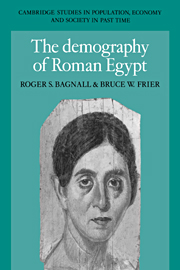Book contents
- Frontmatter
- Contents
- List of figures
- List of tables
- Foreword
- Preface
- A note on references and abbreviations
- 1 The census returns
- 2 The census returns as demographic evidence
- 3 Households
- 4 Female life expectancy
- 5 Male life expectancy and the sex ratio
- 6 Marriage
- 7 Fertility
- 8 Migration
- 9 Conclusion
- Catalogue of census declarations
- Catalogue of census declarations Supplement
- Appendixes
- Bibliography
- Index
- Cambridge Studies in Population, Economy and Society in Past Time
Preface
Published online by Cambridge University Press: 06 January 2010
- Frontmatter
- Contents
- List of figures
- List of tables
- Foreword
- Preface
- A note on references and abbreviations
- 1 The census returns
- 2 The census returns as demographic evidence
- 3 Households
- 4 Female life expectancy
- 5 Male life expectancy and the sex ratio
- 6 Marriage
- 7 Fertility
- 8 Migration
- 9 Conclusion
- Catalogue of census declarations
- Catalogue of census declarations Supplement
- Appendixes
- Bibliography
- Index
- Cambridge Studies in Population, Economy and Society in Past Time
Summary
During the early Roman Empire, the provincial government of Egypt conducted a periodic census of all residents. Among the tens of thousands of documentary papyri from Roman Egypt, there survive just over three hundred census returns filed by ordinary Egyptian declarants. Extant returns run from AD 11/12 down to the last known census in 257/258, but the vast majority date to the second and early third centuries. Their state of preservation varies: some are scraps, but many contain complete or nearly complete registers of Egyptian households. In all, nearly eleven hundred registered persons can now be made out, of whom sex is known for more than a thousand, and age for more than seven hundred. About threequarters of surviving returns come from the Arsinoite and Oxyrhynchite nomes (administrative districts), which lay in Middle Egypt to the southwest of the Nile Delta; other nomes are represented only intermittently.
Although the Egyptian census returns are not free of the flaws that beset all pre-modern censuses, their surprisingly high demographic quality has long been recognized. Early discussion of them from this standpoint culminated in Marcel Hombert and Claude Préaux's classic Recherches sur le recensement dans l'Egypte romaine, published in 1952. Since then, however, research has been spasmodic. The only major demographic contribution is Keith Hopkins's 1980 article on “Brother-Sister Marriage in Roman Egypt.” Hopkins devoted much of this article to exploratory demographic comments on the census returns, which he argued “are far from perfect, but … the best data we have” for ancient populations. Hopkins was the first historian who applied to the returns the sophisticated modelling techniques that modern demographers use when analyzing imperfect data.
- Type
- Chapter
- Information
- The Demography of Roman Egypt , pp. xv - xviiiPublisher: Cambridge University PressPrint publication year: 1994



